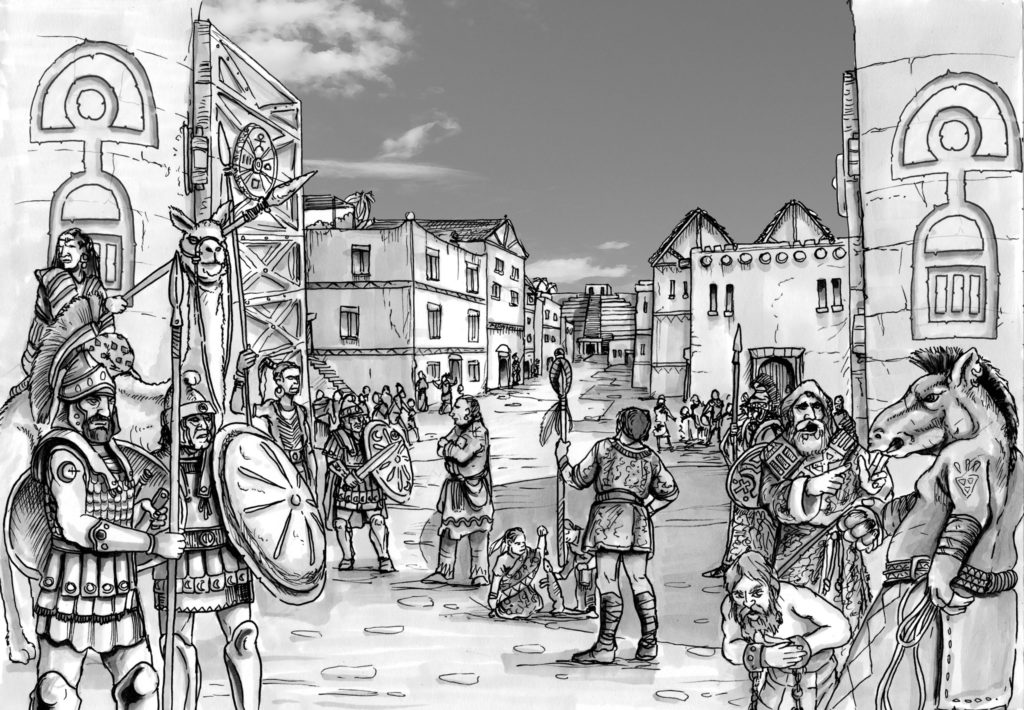Outside of the Big Rubble, there are some 24,000 humans in Pavis County. About 2/3rds of them are Sartarite settlers or their descendants.
The first settlers came with Dorasar in 1550. They established farms along the river, which became the nucleus of new kinship groups. The most important of these was the household of Dorasar, who were a cadet branch of the House of Sartar. Dorasar was a son of Eonistaran the Sage, and his family were great patrons of the Lightbringers cults, especially Orlanth and Lhankor Mhy. This entire family was murdered after the fall of New Pavis to the Lunar Army.
Probably the second most important family was the Garhound family, who claimed fertile lands along the border with Sun County. They became the patrons of many of those who settled south of New Pavis and dominate the Cloth and Leatherworkers Guild, one of the most influential guilds in New Pavis.
Another family worth mentioning is the Indagos family, which came from the Big Rubble. They were given farmlands along the Scritha River, and many left the Big Rubble to settle there in safety.
New Pavis prospered under Dorasar’s leadership and swelled with refugees from war-torn Sartar. His farmers went up and down the river, expanding their holdings and remaining friendly with the nomads. When Dorasar died in 1579, a network of kinship groups, temples, and guilds was able to rule the city.
The wearying troubles between the kingdom of Sartar and the expanding Lunar empire sent many refugees to distant Pavis. The city kept aloof and sent no warriors, though individuals certainly went on their own to fight the distant foe. Many Sartarites came just after Sartar fell, in 1602, when it seemed Pavis was safely out of the line of the Lunar advance. These new refugees either allied themselves with the older families or founded their own kinship groups. This is really the beginning of a more formal clan structure in New Pavis.
The big winners were the heirs of Dorasar, Garhound, Varathanis, Indagos, and Ingilli, whose clans dominated New Pavis. Maybe another dozen lesser kinship groups were strong enough to have their own identity and leaders. Others looked to their guild or temple for support. These include the Cloth and Leatherworkers, Rivermen, Bronze Workers, Jewelers, etc.
IMPORTANT NOTE: There is a LOT of overlap between the major families, the temples, and the guilds. So you might support yourself as a weaver or a leatherworker, which means you belong to the Cloth and Leatherworkers Guild, which is headed up by the Garhound family and strongly associated with the Lightbringers cults. Or you might be a craftsperson living in Suntown, which means looking to the Eiskolli family and the Yelmalio cult as patrons.
These clan structures are much looser than they are in modern Sartar or Heortland, but the city serves as a tribal analogue.
Now when the Lunar Empire conquered New Pavis in 1610, there was a lot of shake up. Dorasar’s heirs were all killed, as were the Varathanis family members. The Garhound family became the most influential family (so much so that Sor-eel was forced to accept their open support of the Orlanth cult), and the Eiskolli family became prominent in Suntown and among the Yelmalio cult.
New settlers came. Many came as refugees from Sartar especially in the wake of Starbrow’s Rebellion. Many retained their ties to their old clans in Sartar, but many were effectively clanless, looking to their temple or guild as their kinship group. Still others came from the Lunar Provinces, former rebels from Talastar, the West Reaches, or the Redlands, and settled land given to the Patroma family by Sor-eel, and they quickly rivaled the Garhound family in influence.
With the liberation of New Pavis by Argrath, things are again shaken up. Argrath’s companions and followers – the White Bull cult – form a powerful block, far greater than any existing kinship group, and tied to him by sacred oaths. But their focus is on Dragon Pass and the Hero Wars, leaving much of the daily affairs to the main families, guilds, and temples.

![]()
![]()
As an aside, I suspect this is actually pretty similar to how things operated in the settlements of Dragon Pass between 1300 and 1400. It took a few generations for those new settlements to really gel into formal clans.
Note that the concept of guilds – in one form or another – are very old. Some of the oldest charters I know of are from Early Achaemenid Mesopotamia, but I wouldn’t be surprised to learn there is earlier evidence of them. Collegium, shreni, za – plenty of good sources beyond just the medieval European guilds. I would advise not getting hung up on the term “guild”. If a group of crafters or traders function as a group, set their own rates, and have their own group identity, they are guild as far as RQ is concerned.
